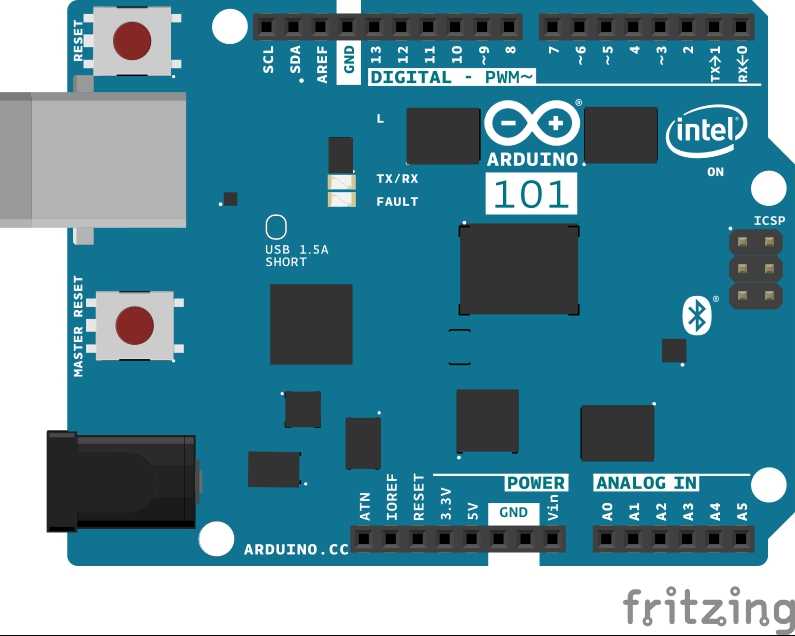Arduino 101 CurieIMU Accelerometer Orientation
With this tutorial you convert the accelerometer readings into an orientation. The orientation is then printed on the Serial monitor as text that tells you the position of the processor, the USB connector and the pins as reference.
Hardware Required
The Circuit

image developed using Fritzing. No additional hardware is needed to use this tutorial.
Software Essentials
Libraries
CurieIMU.h is the library that gives access to all the parameters, features and readings of the IMU chip of the 101 board. This unit contains a three axes accelerometer and a three axes gyroscope. This library is part of the 101 board core and it is loaded together with the core files for Arduino 101. In this tutorial we read the raw accelerometer values.
Functions
None
Code
The orientation of the board is calculated using the orientation of the three axes. The Z axis passes through the pcb: component side upwards is positive, while going below is negative. The X axis goes from USB connector to Bluetooth® antenna if positive, while Y axis goes from analog and power pins to digital pins when positive. Using the three axes signs the sketch calculates the orientation of the whole board.
/*
* Copyright (c) 2016 Intel Corporation. All rights reserved.
* See the bottom of this file for the license terms.
*/
/*
This sketch example demonstrates how the BMI160 on the
Intel(R) Curie(TM) module can be used to read accelerometer data
and translate it to an orientation
*/
#include "CurieIMU.h"
int lastOrientation = - 1; // previous orientation (for comparison)
void setup() {
Serial.begin(9600); // initialize Serial communication
while (!Serial); // wait for the serial port to open
// initialize device
Serial.println("Initializing IMU device...");
CurieIMU.begin();
// Set the accelerometer range to 2G
CurieIMU.setAccelerometerRange(2);
}
void loop() {
int orientation = - 1; // the board's orientation
String orientationString; // string for printing description of orientation
/*
The orientations of the board:
0: flat, processor facing up
1: flat, processor facing down
2: landscape, analog pins down
3: landscape, analog pins up
4: portrait, USB connector up
5: portrait, USB connector down
*/
// read accelerometer:
int x = CurieIMU.readAccelerometer(X_AXIS);
int y = CurieIMU.readAccelerometer(Y_AXIS);
int z = CurieIMU.readAccelerometer(Z_AXIS);
// calculate the absolute values, to determine the largest
int absX = abs(x);
int absY = abs(y);
int absZ = abs(z);
if ( (absZ > absX) && (absZ > absY)) {
// base orientation on Z
if (z > 0) {
orientationString = "up";
orientation = 0;
} else {
orientationString = "down";
orientation = 1;
}
} else if ( (absY > absX) && (absY > absZ)) {
// base orientation on Y
if (y > 0) {
orientationString = "digital pins up";
orientation = 2;
} else {
orientationString = "analog pins up";
orientation = 3;
}
} else {
// base orientation on X
if (x < 0) {
orientationString = "connector up";
orientation = 4;
} else {
orientationString = "connector down";
orientation = 5;
}
}
// if the orientation has changed, print out a description:
if (orientation != lastOrientation) {
Serial.println(orientationString);
lastOrientation = orientation;
}
}
/*
Copyright (c) 2016 Intel Corporation. All rights reserved.
This library is free software; you can redistribute it and/or
modify it under the terms of the GNU Lesser General Public
License as published by the Free Software Foundation; either
version 2.1 of the License, or (at your option) any later version.
This library is distributed in the hope that it will be useful,
but WITHOUT ANY WARRANTY; without even the implied warranty of
MERCHANTABILITY or FITNESS FOR A PARTICULAR PURPOSE. See the GNU
Lesser General Public License for more details.
You should have received a copy of the GNU Lesser General Public
License along with this library; if not, write to the Free Software
Foundation, Inc., 51 Franklin Street, Fifth Floor, Boston, MA 02110-1301 USA
*/